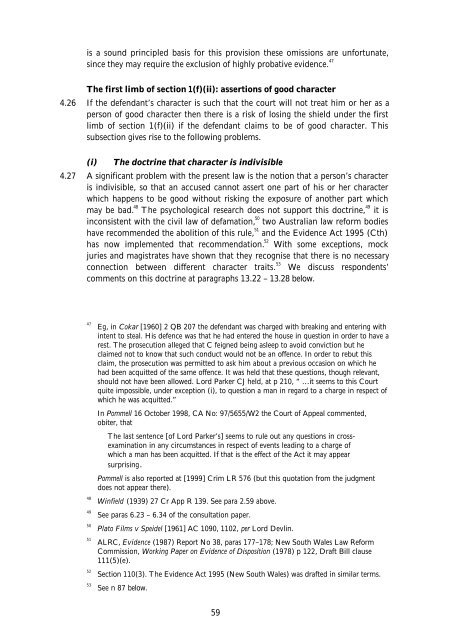Evidence of Bad Character in Criminal ... - Law Commission
Evidence of Bad Character in Criminal ... - Law Commission
Evidence of Bad Character in Criminal ... - Law Commission
Create successful ePaper yourself
Turn your PDF publications into a flip-book with our unique Google optimized e-Paper software.
is a sound pr<strong>in</strong>cipled basis for this provision these omissions are unfortunate,<br />
s<strong>in</strong>ce they may require the exclusion <strong>of</strong> highly probative evidence. 47<br />
The first limb <strong>of</strong> section 1(f)(ii): assertions <strong>of</strong> good character<br />
4.26 If the defendant’s character is such that the court will not treat him or her as a<br />
person <strong>of</strong> good character then there is a risk <strong>of</strong> los<strong>in</strong>g the shield under the first<br />
limb <strong>of</strong> section 1(f)(ii) if the defendant claims to be <strong>of</strong> good character. This<br />
subsection gives rise to the follow<strong>in</strong>g problems.<br />
(i) The doctr<strong>in</strong>e that character is <strong>in</strong>divisible<br />
4.27 A significant problem with the present law is the notion that a person’s character<br />
is <strong>in</strong>divisible, so that an accused cannot assert one part <strong>of</strong> his or her character<br />
which happens to be good without risk<strong>in</strong>g the exposure <strong>of</strong> another part which<br />
may be bad. 48 The psychological research does not support this doctr<strong>in</strong>e, 49 it is<br />
<strong>in</strong>consistent with the civil law <strong>of</strong> defamation, 50 two Australian law reform bodies<br />
have recommended the abolition <strong>of</strong> this rule, 51 and the <strong>Evidence</strong> Act 1995 (Cth)<br />
has now implemented that recommendation. 52 With some exceptions, mock<br />
juries and magistrates have shown that they recognise that there is no necessary<br />
connection between different character traits. 53 We discuss respondents’<br />
comments on this doctr<strong>in</strong>e at paragraphs 13.22 – 13.28 below.<br />
47 Eg, <strong>in</strong> Cokar [1960] 2 QB 207 the defendant was charged with break<strong>in</strong>g and enter<strong>in</strong>g with<br />
<strong>in</strong>tent to steal. His defence was that he had entered the house <strong>in</strong> question <strong>in</strong> order to have a<br />
rest. The prosecution alleged that C feigned be<strong>in</strong>g asleep to avoid conviction but he<br />
claimed not to know that such conduct would not be an <strong>of</strong>fence. In order to rebut this<br />
claim, the prosecution was permitted to ask him about a previous occasion on which he<br />
had been acquitted <strong>of</strong> the same <strong>of</strong>fence. It was held that these questions, though relevant,<br />
should not have been allowed. Lord Parker CJ held, at p 210, “ …it seems to this Court<br />
quite impossible, under exception (i), to question a man <strong>in</strong> regard to a charge <strong>in</strong> respect <strong>of</strong><br />
which he was acquitted.”<br />
In Pommell 16 October 1998, CA No: 97/5655/W2 the Court <strong>of</strong> Appeal commented,<br />
obiter, that<br />
The last sentence [<strong>of</strong> Lord Parker’s] seems to rule out any questions <strong>in</strong> crossexam<strong>in</strong>ation<br />
<strong>in</strong> any circumstances <strong>in</strong> respect <strong>of</strong> events lead<strong>in</strong>g to a charge <strong>of</strong><br />
which a man has been acquitted. If that is the effect <strong>of</strong> the Act it may appear<br />
surpris<strong>in</strong>g.<br />
Pommell is also reported at [1999] Crim LR 576 (but this quotation from the judgment<br />
does not appear there).<br />
48 W<strong>in</strong>field (1939) 27 Cr App R 139. See para 2.59 above.<br />
49 See paras 6.23 – 6.34 <strong>of</strong> the consultation paper.<br />
50 Plato Films v Speidel [1961] AC 1090, 1102, per Lord Devl<strong>in</strong>.<br />
51 ALRC, <strong>Evidence</strong> (1987) Report No 38, paras 177–178; New South Wales <strong>Law</strong> Reform<br />
<strong>Commission</strong>, Work<strong>in</strong>g Paper on <strong>Evidence</strong> <strong>of</strong> Disposition (1978) p 122, Draft Bill clause<br />
111(5)(e).<br />
52 Section 110(3). The <strong>Evidence</strong> Act 1995 (New South Wales) was drafted <strong>in</strong> similar terms.<br />
53 See n 87 below.<br />
59

















